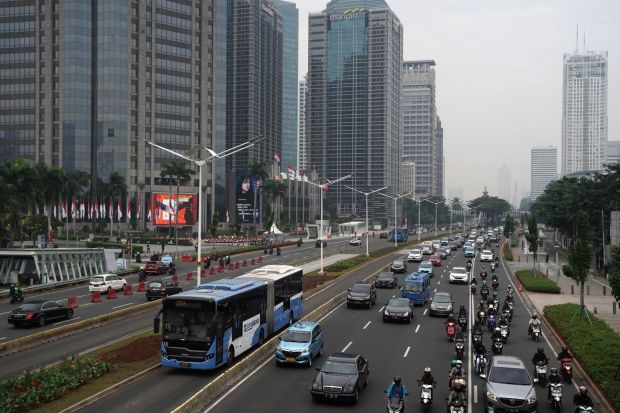Indonesia’s Q2 GDP contraction draws mixed views from economists
ECONOMISTS appear mixed on Indonesia’s economic outlook following the release of its second-quarter gross domestic product (GDP) on Wednesday.
Indonesia’s Q2 GDP shrank by a 5.3 per cent year on year, which was sharper than the 4.7 per cent predicted by private-sector economists, according to a Bloomberg poll. This is Indonesia’s weakest showing since the Q1 1999, during the Asian Financial Crisis. The country’s central bank had meanwhile projected a contraction of 4.8 per cent in Q2, against a 3 per cent year-on-year growth in Q1.
Brian Tan, Barclays Investment Bank’s regional economist, noted that private consumption, government consumption and fixed investment all fell in Q2 as social distancing measures under Indonesia’s large-scale social restriction measures, or Pembatasan Sosial Berskala Besar (PSBB), have stifled economic activity. This led to a collapse in imports, which outpaced the decline in exports, he said in a report.
Barclays is thus slashing its 2020 GDP forecast further to a 1.3 per cent contraction, down from a 1 per cent contraction, Mr Tan said, which is below the central bank’s earlier GDP growth forecast range of 0.9 to 1.9 per cent.
“Despite the imposition of the PSBB in parts of the country, the Covid-19 outbreak does not appear to be under control in Indonesia, with reports of new infections still trending higher. As a result, we think firms and households are likely to remain cautious in resuming economic activities,” Mr Tan said.
DBS Group Research economist Radhika Rao said in a report that the bank is maintaining its forecast of a 1 per cent contraction, with marginal downside risks.
“Q2 likely marked the steepest part of the decline in output and we expect headline GDP to return to growth by Q4 assuming infection rate stabilises, reopen remains apace, and government disbursements are hastened,” Ms Rao said. Even so, she noted that Indonesia’s response to Covid-19 was less stringent than most of its Asean peers, hence necessitating higher vigilance on containing the infection curve when rules are being lifted.
Helmi Arman, Citi’s chief economist for Indonesia, said the bank is revising its 2020 GDP forecast upwards, given that the contraction of GDP in Q2, at the height of the mobility restriction period, was “significant but milder than our expectation”. Citi had initially predicted a 7.9 per cent contraction.
The bank is expecting the economy to reclaim another 20 per cent of the lost GDP in Q4, which means 2020 full-year GDP could be just 1 to 2 per cent lower than expected for 2021 and better than the bank’s initial expectation of a 4 per cent contraction, Mr Arman said in a report.
In terms of monetary policy, Barclays’ Mr Tan said he is expecting the central bank to keep its policy rate steady for a few months before resuming further cuts later this year.
“While we continue to expect Bank Indonesia (BI) to reduce its policy rate by another 50bp to 3.5 per cent this year, the weakening trend in the currency suggests a short pause is likely,” Mr Tan said.
DBS’s Ms Rao said BI has cut rates by 75 bps so far in 2020 to 4 per cent, and it has room to cut by another 25bp if the economy continue to weaken, given the “tame inflation”.
Citi’s Mr Arman believes Q2’s larger-than-expected contraction is not likely to significantly affect the policy rate outlook.
“We have been expecting no further rate cuts from here and standby our view that any change to this call will have to be dependent on Indonesia seeing sizable and sustained portfolio inflows into the bond market,” Mr Arman said.


 Thailand
Thailand




